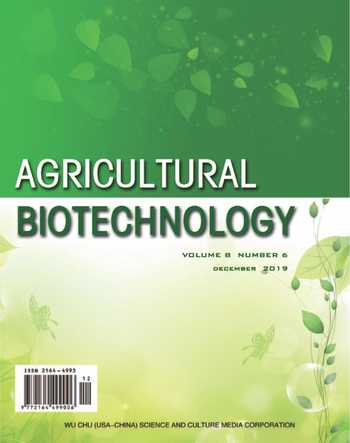Evaluation on Application and Spraying Effect of AirAssisted Sprayer in Apple Orchard with Dwarfing Rootstocks
Xiaoman JIA Yunqiang HAN Yong ZHANG Xingyuan MEN Lili LI Hao ZHAI
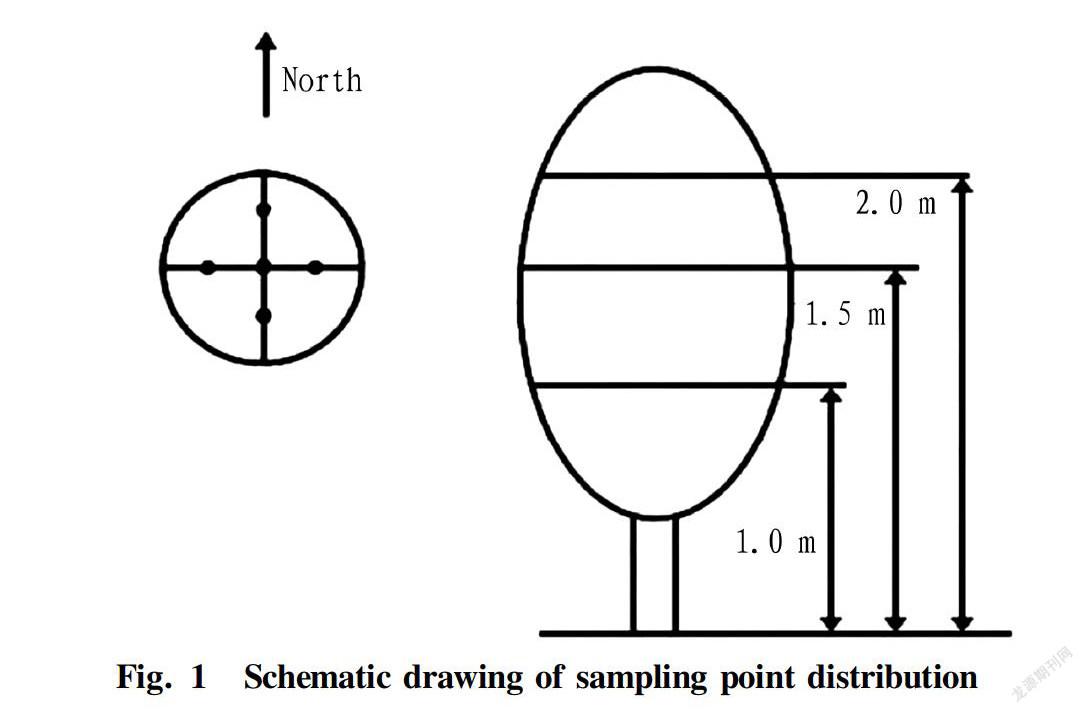

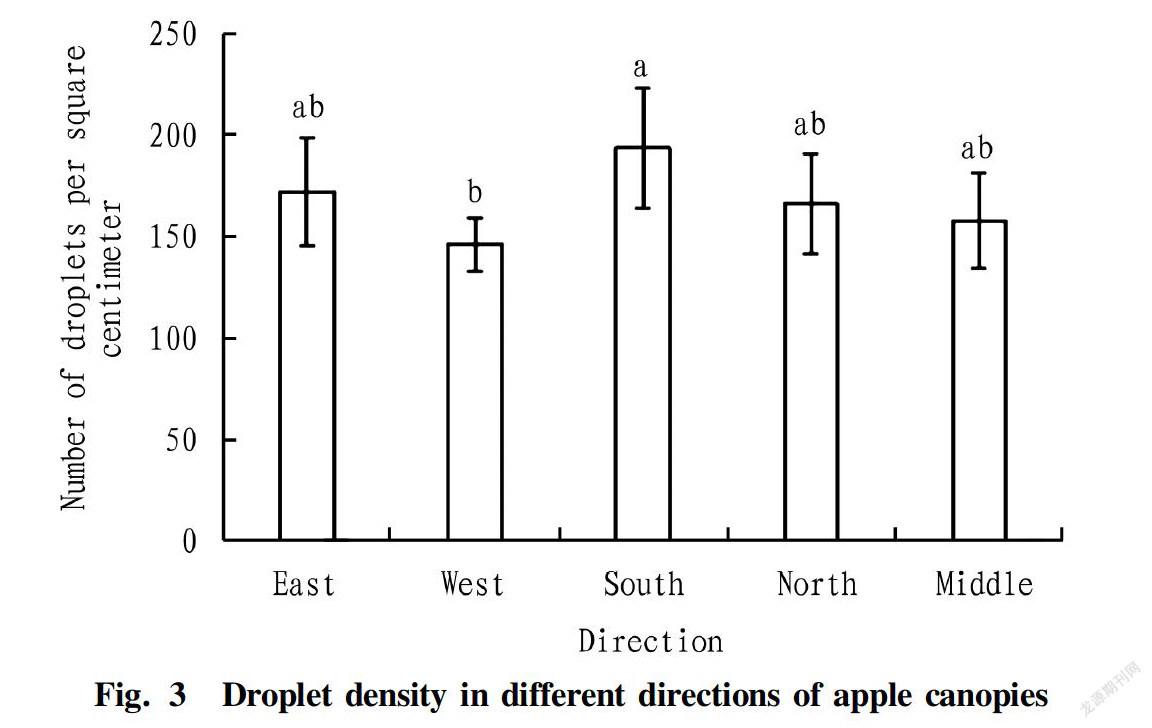
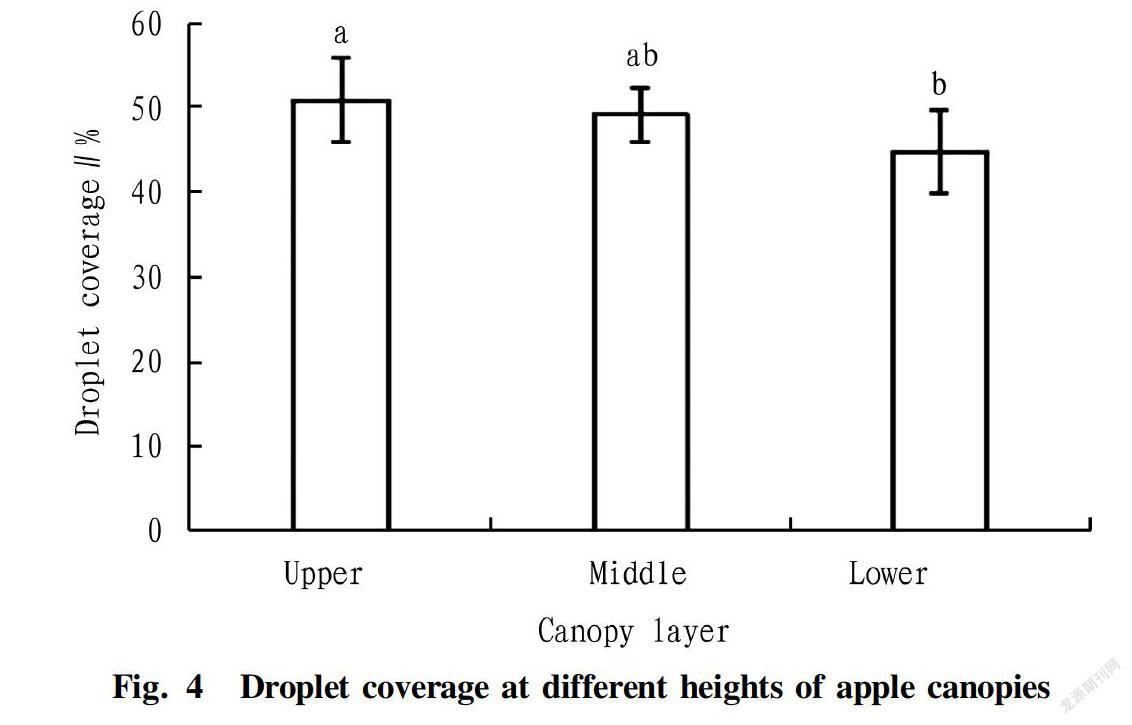
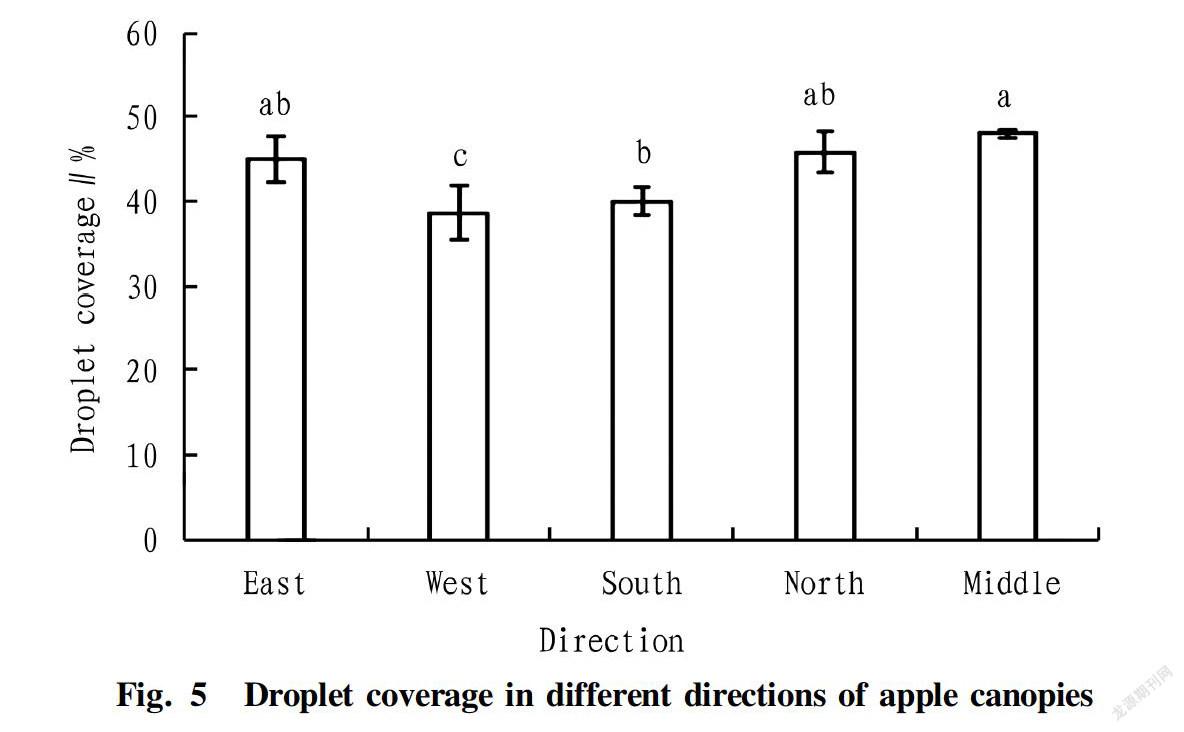
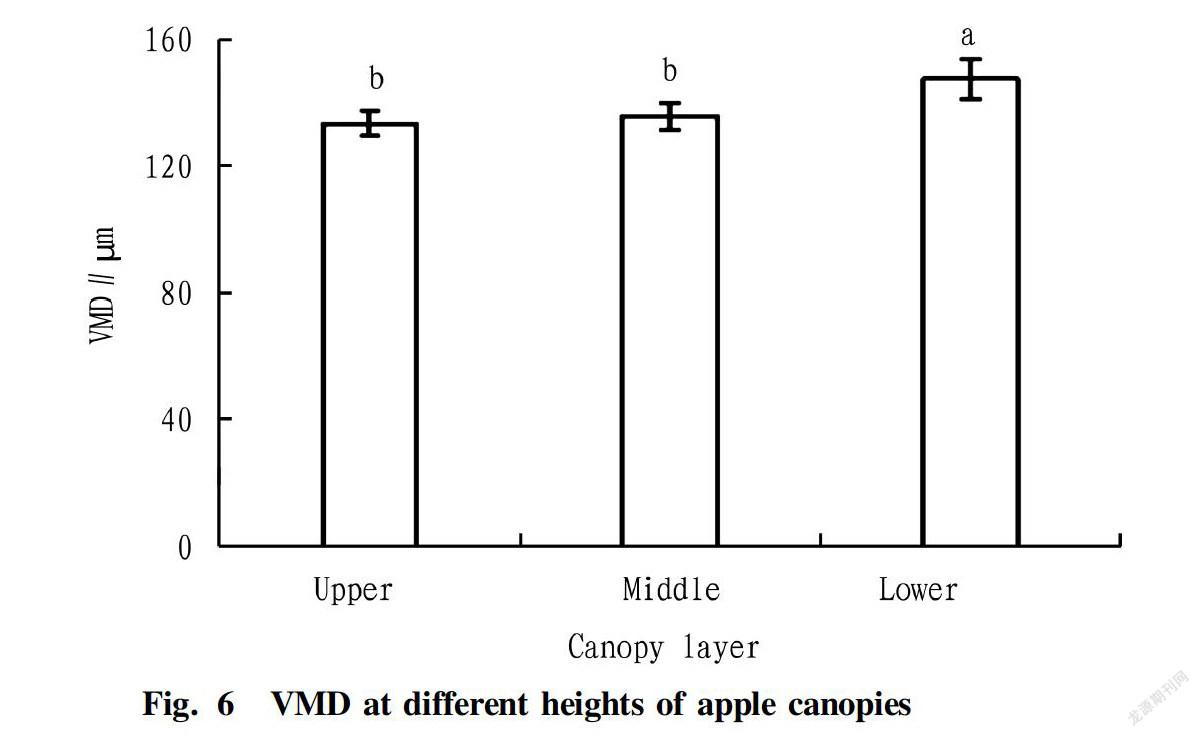
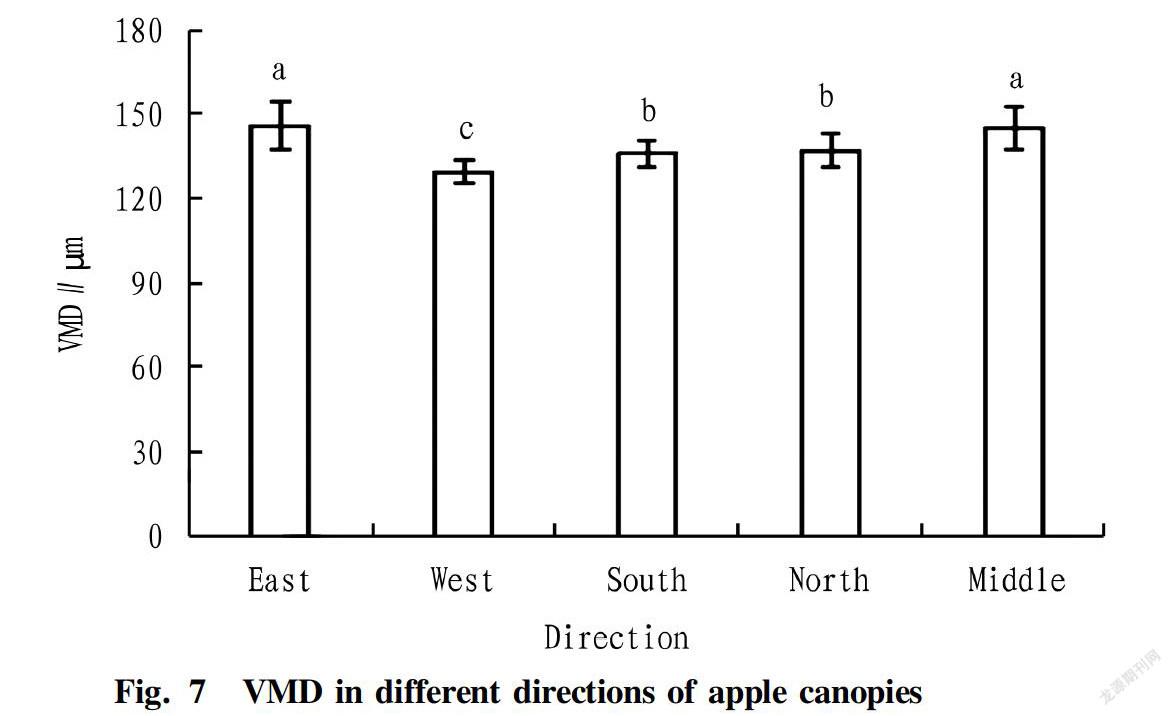
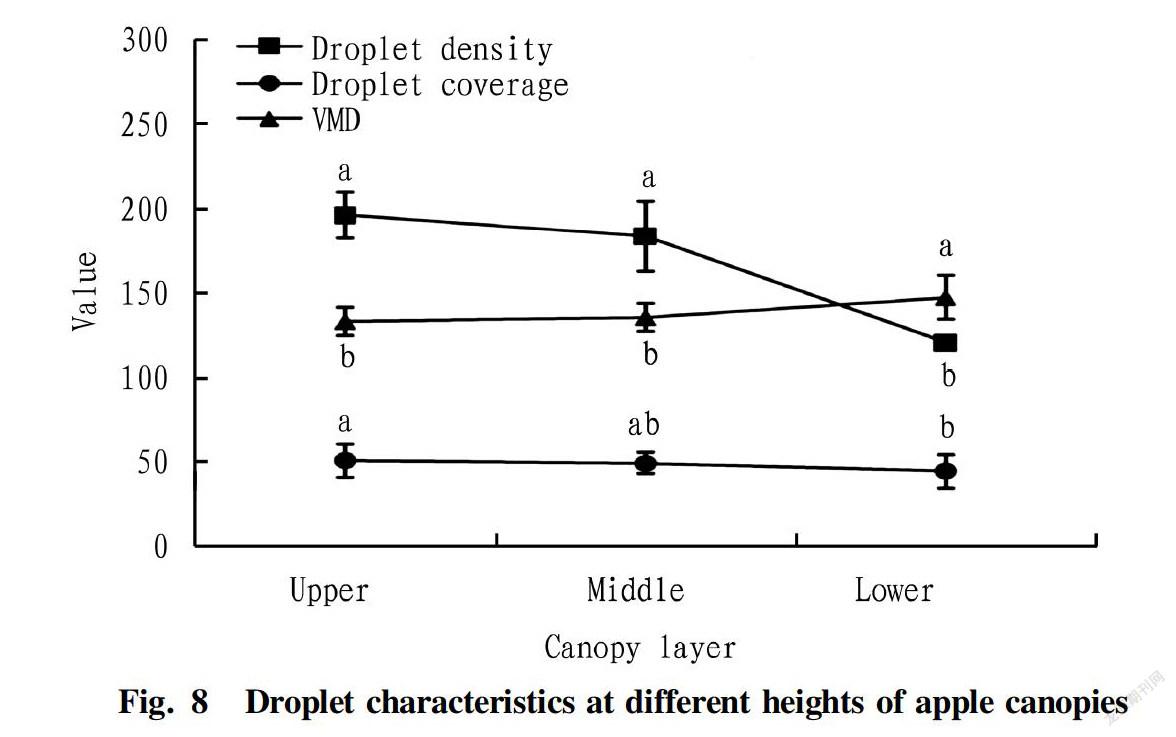
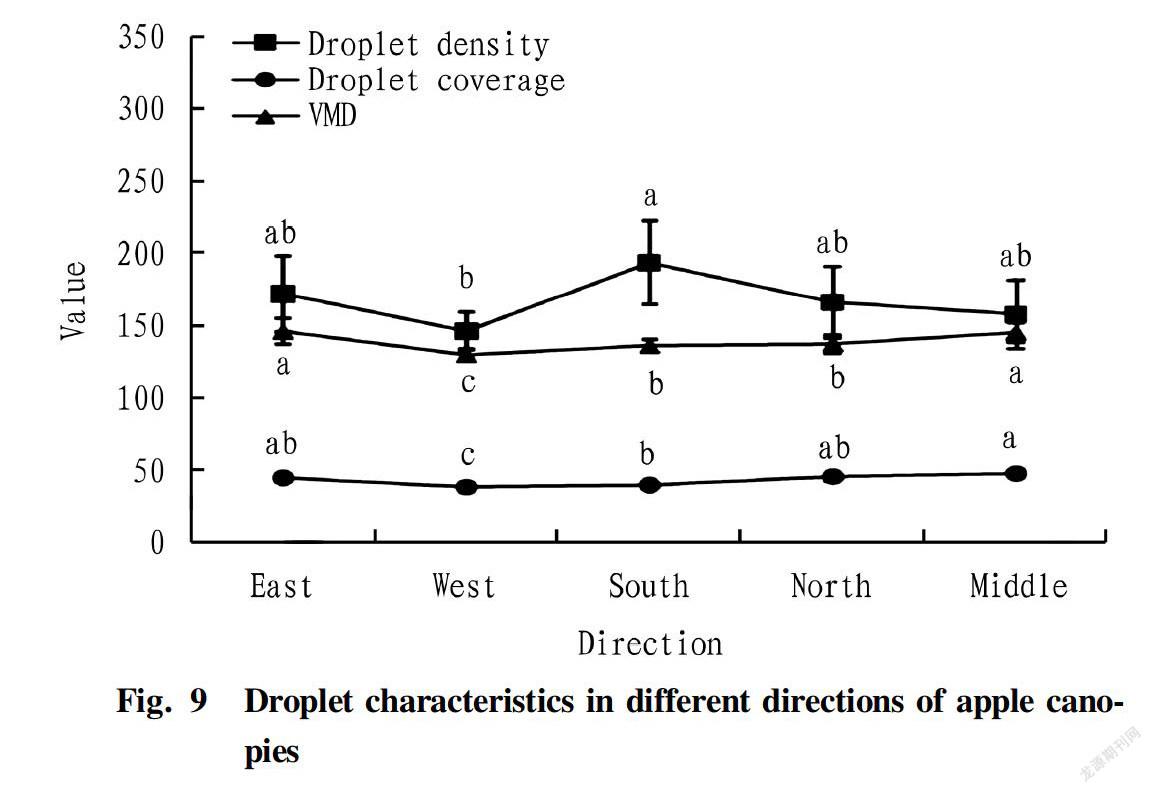
Abstract The application and spraying effect of 3WG1200A airassisted sprayer in dwarfing rootstock apple orchard were evaluated by investigating the droplet density, coverage and volume median diameter (VMD) in different canopy layers (2.0, 1.5, 1.0 m) and five directions (east, south, west, north and middle) of apple trees. The results showed that the droplet density was 166.99 per square centimeter, the coverage was 48.23%, and the VMD was 138.63 μm. The droplet density in different canopy layers of the trees had consistent trend with the coverage. The droplet density and coverage in the upper and middle canopy (2.0 m and 1.5 m) had no significant difference, but they were both higher than those in the lower canopy, while the VMD in different canopy layers showed an opposite trend. The change trends of the coverage and VMD in the five directions were consistent, and the values in the middle and east were the highest, followed by the north, south and west, respectively. The results indicated that droplet characteristics of the 3WG1200A airassisted sprayer met the basic requirements for pest and pathogen control. This study provides a theoretical basis and data support for the application and improvement of orchard application equipments in dwarfing rootstock apple orchard.
Key words Apple orchard; Airassisted sprayer; Droplet density; Droplet coverage; Droplet volume median diameter
Received: June 3, 2019Accepted: August 29, 2019
Supported by Shandong Key Research and Development Program (2017CXGC0214); Taian Science and Technology Development Project (2017NS0091).
Xiaoman JIA (1991-), female, P. R. China, master, devoted to research about fruit tree diseases.
*Corresponding author. Email: zhaihao688@163.com.
Since the late 1980s and early 1990s, the apple cultivation model based on denselyplanted apple rootstocks has promoted the rapid development of Chinas apple industry. However, this model has a serious overlap of tree canopies in the mature period, and it is difficult for working machinery to enter. These problems seriously affect the effect of mechanical operations and increase the difficulty of research and promotion of orchard machinery. Highdensity planting mode based on dwarfing rootstocks has the advantages of short crown, good ventilation and light reception, time and labor saving, early fruiting, no alternate bearing and good fruit quality. Therefore, the transition of highdensity planting from standard rootstocks to dwarfing rootstocks is the development direction of the apple industry in China[1].
At present, the conventional pesticide application instruments in Chinas orchards are still dominated by small mobile orchard sprayers[2]. There are problems such as low application efficiency, unstable spray pressure, uneven atomization, short range, poor penetrability, serious waste of liquid pesticide, etc., which result in toohigh labor and pesticide costs in orchard application, which affects the diversity of the ecological environment of orchards and the safe production of fruit. Mechanization is an important symbol of modern orchard production, and mechanized pesticide application is an important part of orchard mechanization. Most of the modern application instruments are large and mediumsized orchard sprayers, which have the advantages of low work intensity, good safety, high utilization rate and high control effect, and are especially suitable for highdensity planting with dwarfing rootstocks in wide rows. At present, the pesticide application instruments in modern orchards in China are mainly airassistant sprayers, which can convey droplets with the assistance of air, and can increase the coverage of droplets on the back of the leaves and inside the tree body. However, with the promotion and application of large and mediumsized orchard application instruments in modern orchards, the problems are increasingly prominent. On the one hand, the orchard construction is not standardized, and different types of dwarfing rootstocks are used for cultivation during the construction of orchards, resulting in a large difference in tree size and tree crown[3], which increases the difficulty of mechanized application. On the other hand, orchard pesticide application instruments have complicated brands and models, and differ in work performance, increasing the difficulty in application instrument selection. In order to enable fruit farmers to select suitable pesticide application instruments, it is necessary to conduct a standardized evaluation of different application machines in combination with cultivation mode, tree shape and topography.
In this study, the application and spraying effect of 3WG1200A airassisted sprayer in dwarfing rootstock apple orchard was evaluated by investigating the droplet density, coverage and volume median diameter (VMD) in different canopy layers (2.0, 1.5, 1.0 m) and five directions (east, south, west, north and middle) of apple trees, with an attempt to provide reference for fruit farmers to choose pesticide application machines suitable for dwarfing rootstock apple orchards.
Materials and Methods
Experimental materials
Pesticide application instrument: 3WG1200A airassisted sprayer (Nantong Huanghai Chemical Machinery Co., Ltd., spraying height: 8-9 m, spraying width: 18-20 m, volume: 1 200 L).
Experiment orchard: The dwarfing rootstock apple orchard in Feicheng City, Shandong Province, in which the tested fiveyearold Yanfu 3 apple trees had dwarfing rootstocks and spindleshaped canopy, and were densely planted with a row spacing of 2.0 m×4.0 m, in northsouth direction. Grasses naturally grew in the orchard.
Experimental methods
A 3WG1200A airassisted fruit sprayer with a water consumption of 75 L for 666.7 m2 was used. The sprayer was placed in the east of the tree. Before spraying, five fruit trees were randomly selected in the direction perpendicular to the spraying zone in each plot. The canopy was divided into upper, middle and lower layers, with heights of 2.0, 1.5 and 1.0 m, respectively. Five points in the east, south, west, north and middle of each tree were selected as the sampling points (Fig. 1). A watersensitive paper droplet test card (produced by the Institute of Plant Protection, Chinese Academy of Agricultural Sciences) was fixed with a paper clip at the back of a certain leaf at each point, with the detection face downward. After the spraying, the dried watersensitive paper was taken out, put into a plastic bag, and brought back to the laboratory for scanning. The droplet density, coverage and VMD were analyzed by using the Liuliushanxia Droplet Analysis Software (Chongqing Liuliushanxia Plant Protection Technology Co., Ltd.).
Data analysis
Plotting was performed with Microsoft Excel 2007. Analysis of significance of difference was performed using DPS 16.05 statistical software.
Results and Analysis
Distribution of droplet density in the tree canopies
The distribution of droplet density in the upper, middle and lower canopy layers formed by the airassisted sprayer is shown in Fig. 2. The average droplet density in the trees was 166.99 droplets per square centimeter. Specifically, the density in the lower canopy layer was 120.99, which was significantly lower than 196.47 in the upper canopy layer and 183.52 in the middle canopy layer. The coefficient of variation of the droplet density was the largest at 23% in the middle canopy layer, followed by the upper and lower canopy layers (14% and 6%, respectively).
The droplet density of the sprayer was 171.92, 193.48, 166.02, and 157.74 per square centimeter in the east, south, north and middle of the trees, respectively, and the differences were not significant. The density of droplets in the south part of the trees was significantly higher than that in the west (Fig. 3). The coefficient of variation of the droplet density was the smallest in the west (18%) among different orientations of the trees, and the remaining four were all 30%.
Different lowercase letters on the columns indicate that the difference is significant at the 5% level, the same below.
Distribution of droplet coverage in the tree canopies
It can be seen from Fig. 4 that the average droplet coverage of the airassisted sprayer in the whole trees was 48.23%. Specifically, the droplet coverage in the upper canopy layer was 50.82%, which was significantly higher than the lower canopy (44.69%), but had no significant difference with the middle canopy (49.16%). The droplet coverage of tree showed the largest coefficient of variation at 22% in the lower canopy, followed by the upper and middle canopy layers (19% and 13%, respectively).
It can be seen from Fig. 5 that the droplet coverage was the largest in the middle of the trees, at 48.03%, which was significantly higher than the west and the south. The droplet coverage was 45.07% and 45.85% in the east and the north of the trees, respectively, which were not significantly different from that in the middle of the trees. The west part of the trees exhibited the smallest coverage, which was significantly lower than other orientations of the trees. The variation coefficient of droplet coverage in different orientations of the tree was the smallest in the middle, and increased sequentially in the south, north, east and west, which were at 8%, 11%, 12% and 17%, respectively.
Xiaoman JIA et al. Evaluation on Application and Spraying Effect of AirAssisted Sprayer in Apple Orchard with Dwarfing Rootstocks
Distribution of VDM in the tree canopies
Fig. 6 shows that the average VMD of the airassisted sprayer in the whole trees was 138.63 μm. Specifically, the VMD in the lower canopy was 147.20 μm, which was significantly higher than the upper layer (133.22 μm) and the middle layer (135.47 μm). The variation coefficient of the VMD was 9% in the lower layer and 6% in both the upper and middle layers of the trees. Among the five directions, i.e., the east, south, west, north and middle of the trees, the west, south and north parts showed VMDs of 129.52, 135.93 and 136.96 μm, respectively, which were significantly lower than the east (145.78 μm) and the middle (144.96 μm), as shown in Fig. 7. The coefficient of variation of VMD was the largest in the east (12%), followed by the middle and north parts (10% and 8%, respectively), and the smallest in the south and west (7% and 6%, respectively) of the trees.
Analysis of droplet distribution in different parts of the tree canopies
The droplet density and coverage of the airassisted sprayer were consistent in the upper, middle and lower canopy layers of the trees. The droplet density and coverage of the upper canopy layer of the trees were not significantly different from those of the middle canopy, but the values in the two layers were all larger than the lower canopy. The trend of VMD in the upper, middle and lower canopy layers was opposite to that, i.e., the VMD of the lower canopy was significantly larger than the middle layer and upper layer (Fig. 8).
The droplet coverage and size of the airassisted sprayer were consistent in the five directions, i.e., the east, south, west, north and middle of the trees. The droplet coverage and size of the trees were the largest in the east, sequentially followed by the north, south and west. The droplet density of the sprayer was larger in the east, south, north and middle of the trees than in the west (Fig. 9).
Discussion and Conclusions
In recent years, with the transformation and upgrading of the apple industry, modern spraying equipment is widely used in dwarfing rootstock orchards, which is efficient and laborsaving, but there is a lack of application evaluation in orchards. Therefore, it is urgent to evaluate the application effect of modern large and mediumsized pesticide application equipment in orchards by combining the type of orchard and the performance parameters of the pesticide application machinery.
The VMD, coverage and density of pesticide droplets and the preparation concentration of pesticide liquids have significant effects on the efficacy of pesticides, germicides and herbicides[4], and are the necessary indicators for evaluating pesticide application techniques[5]. The effect of single droplets is much larger than the VMD range. Within a certain area, as long as the number of droplets reaches a certain value, a better control effect can be achieved[4,6]. Ding et al.[7] reported that the droplet density required for pest control should reach more than 20 per square centimeter, while the average droplet density of the airassisted sprayer in this study was 166.99, which fully meets the requirements of conventional application.
The VMD, that is, the droplet diameter, is an important indicator for measuring the degree of atomization of the liquid and comparing the atomization quality of various nozzles[8]. During the spraying of pesticides, the VMD directly affects the use efficiency, deposition amount and distribution of the active components of pesticides[9-12]. There is a biological optimal VMD relationship between the VMD and the efficacy of a pesticide. The use of fine droplets of 10 to 50 μm is suitable for the control of flying pests, droplets of 30 to 150 μm is suitable for the control of leaf reptile pest larvae and plant diseases, and coarser droplets from 100 to 300 μm is suitable for herbicide spraying[4,13-14]. The plant type, leaf surface characteristics, cultivated years and species of pests and diseases of different crops are different, and the optimal VMD is also different[15].
In this study, the VMD of the airassisted sprayer is 138.63 μm, which is in line with the VMD requirements for controlling pests and diseases. As a perennial cash crop, the branches of apple suffer from severer diseases. Because the mutual covering between the leaves reduces the adhesion of pesticide liquids to branches, it is recommended to appropriately increase the pressure, reduce the air supply speed or use a nozzle with better atomization effect, so as to reduce the VMD and improve the spraying effect. The VMD characteristics of different orientations are different, and in addition to comparing the mean value, the coefficient of variation should also be analyzed to eliminate the influence of the difference in the mean value on the degree of variation of the droplet characteristics in each orientation[16-17]. The coefficient of variation of the droplet coverage in the middle layer of apple canopies was samller than those in the lower layer and the upper layer, and the coefficient of variation of the VMD was the same in the middle and upper layers, both of which were smaller than that of the lower layer, indicating that the VMD and distribution of droplets in the middle layer were relatively uniform, but the coefficient of variation of the droplet density in this layer was large and may be related to the dense branches and leaves which cover each other. Among the five different orientations of apple canopies, the west orientation showed the smallest variation coefficients of droplet density and VMD and the largest variation coefficient of coverage, which may be due to the greater overlap of the canopies in the west, which results in a large change in coverage.
Yuan et al.[4] showed that under the same application rate, the VMD is inversely proportional to the density, and is reduced by half when the number of droplets is increased by 8 times. In this study, the trends of the droplet density and size of the airassisted sprayer at different heights also proved this: the upper and middle layers were not significantly different in the droplet density and coverage, but were both larger than the lower canopy, while the change of the VMD was opposite, that is, the VMD of the lower canopy layer was significantly higher than those of the upper and middle layers. It is speculated that the middle and lower branches and leaves of the spindleshaped tree are dense, and large droplets are easily deposited on the lower layer, resulting in a larger VMD than the upper and middle layers.
The droplet coverage and size were consistent in the five directions, i.e., the east, south, west, north and middle of the trees. The droplet coverage and size in such three directions of the trees as the middle, south and west were higher than those of south and west. The differences of droplet density among the five directions were obvious, and the droplet density was larger in the east, south, north and middle directions of the trees than that in the west. It may be because the fruit trees were planted in the northsouth direction, and the spraying was performed from the east, while the west part of the canopies was covered more, and large droplets are deposited too early and small droplets have a good dispersion effect, resulting in the droplet density and size in the west part smaller than the other four directions.
In summary, the 3WG1200A airassisted fruit sprayer delivers liquid pesticides in the modern apple orchard with dwarfing rootstocks by air, which churns the branches and leaves, and has the advantages of small pesticide droplets, strong penetrability, uniform dispersion, high work efficiency and wide application range. It can meet the basic requirements of pest control, and is suitable for the pesticide application in intensivelycultivated highdensity apple orchards with dwarfing rootstocks.
References
[1] HAO F. Evaluation on benefit of intensive apple cultivation techniques with dwarfing rootstocks[D]. Yangling: Northwest A&F University, 2014.(in Chinese)
[2] ZHANG PJ, GAO Y, SHI GC, et al. Effects of different pesticide sprayers on betacyfluthrin EW for controlling the peach fruit moth (Carposina niponensis Walsingham) in orchard[J]. Journal of Fruit Science, 2016, 33(7): 850-856.(in Chinese)
[3] DESMOND RL, JIANG Z, RUSHING JW. Tree fruit reflective film improves red skin coloration and advances maturity in peach[J]. Hort Technology, 2001, 1(2): 234-242.
[4] YUAN HZ, WANG GB. Effects of droplet size and deposition density on field efficacy of pesticides[J]. Plant Protection, 2015, 41(6) : 9-16.(in Chinese)
[5] ZHANG WJ. Study on atomization of pesticide droplets and sedimentation characteristics on corn plants[D]. Beijing: China Agricultural University, 2014. (in Chinese)
[6] FORD MG, SALT DW. Behaviour of insecticide deposits and their transfer from plant to insect surfaces[J]. Pesticides on Plant Surfaces, 1987: 26-81.
[7] DING SM, FU XM, XUE XY, et al. Design and experiment of selfpropelled airassisted sprayer in orchard with dwarf culture[J]. Transactions of the Chinese Society of Agricultural Engineering, 2013, 29( 15) : 18-25.(in Chinese)
[8] YUAN HZ, XU YM, RUI CH. Pesticide application guide[M]. Beijing: China Agricultural?Science?and Technology?Press, 2011.(in Chinese)
[9] ZHU JW, SHI J, ZHU GN, et al. Influence of droplet size and spray volume on retention of chlorpyrifos on cabbage leaves[J]. China Vegetables, 2003(6): 3-5.(in Chinese)
[10] SONG JL, HE XK, ZENG AJ, et al. Spraying quality of three kinds of orchard plant protection equipment[J]. Journal of Chinese Agricultural Mechanization, 2006(5): 79-82.(in Chinese)
[11] DENG W, MENG ZJ, CHEN LP, et al. Measurement methods of spray droplet size and velocity[J]. Journal of Agricultural Mechanization Research, 2011, 33(5) : 26-30.(in Chinese)
[12] YU Q, FAN RJ, LIU ZF, et al. Effects of droplet density, spraying volume and spraying equipment on efficacy of abamectin microemulsion against Panonychus ulmi in apple tree[J]. Journal of Fruit Science, 2016, 33(1) : 81-87.(in Chinese)
[13] HU GQ, XU LY, ZHOU HP, et al. Analysis of multifactor influence on droplet size distribution of hollow cone nozzle[J]. Journal of Nanjing Forestry University: Natural Sciences, 2014, 38(2): 133-136.(in Chinese)
[14] SOLANG U. Traceing insecticide spray droplets by sizes on natural surfaces. The state of the art and its value[J]. Pesticide Science, 2006, 8 (5): 501-509.
[15] LAN YB, PENG J, JIN J. Research status and development of pesticide spraying droplet size[J]. Journal of South China Agricultural University, 2016, 37(6): 1-9. (in Chinese)
[16] HE L, WANG GB, HU T, et al. Influences of spray adjuvants and spray volume on the droplet deposition distribution with unmanned aerial vehicle (UAV) spraying on rice[J]. Journal of Plant Protection, 2017, 44(6): 1046-1052.(in Chinese)
[17] GUAN XB, KONG X, QI P, et al. Effects of application operations of different pesticide application instruments on pesticide deposition rate and wheat aphid control[J]. Agriculture of Henan, 2018(18): 43-44, 46. (in Chinese)
- 农业生物技术(英文版)的其它文章
- Observation on Cardiac Opening of the Inferior Vena Cava in Goat Fetuses
- Problems in the Development of Traditional Chinese Medicinal Materials Planting Industry in Shiyan City and Countermeasures
- Study on Practical Mature Age of Individual Pinus thunbergii×P. densiflora
- Effects of Different Densityreducing Methods on Canopy Microenvironment, Tree Growth and Fruit Quality in Closed Apple Orchard
- Development of Whole Potato Flour Fish Noodles
- Preparation of Alkalisoluble Pachymaran Rice Wine

